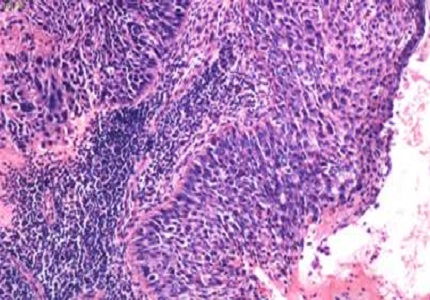Cell blocks prepared from gynaecologic liquid based specimens: as a source for further ancillary techniques
Abstract
Background: Cervical cancer is the second most common cancer among women worldwide and leading causes of cancer deaths amongst women. Cell blocks prepared from liquid-based specimens can serve as a useful adjunct and cell blocks can be further subjected for ancillary molecular techniques.
Materials and Methods: In the present study 60 cell blocks were prepared from Manual liquid-basedcytology (MLBC) specimen collected in liquid fixative. Results were compared with cytology smears and histopathological correlation was obtained in 19 cases. P16 and Ki67 were used whenever required.
Results: In the present study out of 60 cases of cell blocks 10 cases had no deposit. Of the other 50 cases, 7 cases (14%) were neoplastic and 43(86%) were non-neoplastic. The sensitivity and specificity of cell block, LBC and CPS were 75% and 93%, 66% and 84%, 50% and 70% respectively for neoplastic lesions of cervix. Concordance Rate of CB/Histopathology Vs CPS/Histopathology is 74% vs. 54%. Ki 67 and p16INK4a were used whenever sample was sufficient.
Conclusion: In the present study we found that cell blocks prepared from the LBC specimens aid in the diagnosis of neoplastic lesions of cervix and are particularly valuable in distinguishing carcinoma cervix from intraepithelial lesions. Cell blocks can be further subjected to ancillary tools like immunohistochemistry and HPV- DNA testing.
Downloads
References
2. Kavatkar AN, Nagwanshi CA, Dabak SM.Study of a manual method of liquid-based cervical cytology.Indian J PatholMicrobiol.2008Apr-Jun;51(2):190-4. [PubMed]
3. Alves VA, Bibbo M, Schmitt FC, Milanezi F, Longatto Filho A.Comparison of manual and automated methods of liquid-based cytology. A morphologic study.Acta Cytol.2004Mar-Apr;48(2):187-93.
4. Lee JM, Kelly D, Gravitt PE, Fansler Z, MaksemJA, Clark DP.Validation of a low-cost, liquid-based screening method for cervical intraepithelial neoplasia.Am JObstetGynecol.2006Oct;195(4):965-70. Epub2006Apr 19. [PubMed]
5. Richard K, Dziura B, Hornish A.Cell block preparation as a diagnostic technique complementary to fluid-based monolayer cervicovaginal specimens.Acta Cytol.1999Jan-Feb;43(1):69-73.
6. Nathan NA, Narayan E, Smith MM, Horn MJ. Cell block cytology. Improved preparation and its efficacy in diagnostic cytology.Am J Clin Pathol. 2000 Oct;114(4):599-606.
7. Saqi A. The State of Cell Blocks and Ancillary Testing: Past, Present, and Future.Arch Pathol Lab Med. 2016 Dec;140(12):1318-1322. Epub 2016 Aug 24. [PubMed]
8. Keyhani-Rofagha S, Vesey-Shecket M.Diagnostic value, feasibility, and validity of preparing cell blocks from fluid-based gynecologic cytology specimens.Cancer.2002Aug25;96(4):204-9.
9. Yeoh GP, Chan KW. Cell block preparation on residual ThinPrep sample.Diagn Cytopathol. 1999 Dec;21(6):427-31. [PubMed]
10. Díaz-Rosario LA, Kabawat SE.Performance of a fluid-based, thin-layer papanicolaou smear method in the clinical setting of an independent laboratory and an outpatient screening population in New England.Arch Pathol Lab Med.1999Sep;123(9):817-21.
11.Catteau X, Simon P, Noël JC. Detection of High-Grade Lesions on Cell Blocks from Residual Fluids of Pap Smears Diagnosed as Low-Grade Abnormalities: A Preliminary Pilot Study. Acta Cytologica 2012; 56: 247-50.
12. George MV, ShidhamVB, MehrotraR, Amore K L, Hunt B, Narayan R.p16 INK4a immunocytochemistry on cell blocks as an adjunct to cervical cytology: Potential reflex testing on specially prepared cell blocks from residual liquid-based cytology specimens. Cytojournal.2011 Jan; 8:1-10.
13. Gangane N, Mukerji MS, Anshu,Sharma SM.Utility of microwave Processed cell blocks as a complement to cervico-vaginal smear. Diagcytopathol. 2007 Jun; 35(6):338-41.
14. Wei Q, Liu J, Zhang Z, Yang Q, Zhao T. Morphological features of cell blocks prepared from residual Liqui-PREP samples can distinguish between High-grade squamous intraepithelial lesions and squamous cell carcinomas. Acta Cytol. 2011 Apr; 55(3):245-50.
15. Gupta S, Halder K, Khan VA, Sodhani P.Cell block as an adjunct to conventional Papanicolaou smear for diagnosis of cervical cancer in resource-limited settings.Cytopathology.2007Oct;18(5):309-15. Epub2007 Aug 6. [PubMed]
16. Catteau X, Simon P, Noël JC. Detection of High-Grade Lesions on Cell Blocks from Residual Fluids of Pap Smears Diagnosed as Low-Grade Abnormalities: A Preliminary Pilot Study. Acta Cytologica 2012 Apr; 56(3): 247-50.
17. Yemelyanova A, Gravitt PE, Ronnett BM, Rositch AF, Ogurtsova A, Seidman J, Roden RB.Immunohistochemical detection of human papillomavirus capsid proteins L1 and L2 in squamous intraepithelial lesions: potential utility in diagnosis and management.Mod Pathol. 2013 Feb;26(2):268-74. doi: 10.1038/modpathol.2012.156. Epub2012 Sep 21.
18. Nandini NM, Nandish SM, Pallavi P, Chandrashekhar AP, Anjali S, Dhar M Manual Liquid Based Cytology in Primary Screening for Cervical Cancer - a Cost Effective Preposition for Scarce Resource Setting. Asian Pacific J Cancer Prev. 2012; 13(8):3645-51.
19. Akpolat I, Smith D, Ramzy I, Chirala M, Mody D R. The Utility of p16INK4a and Ki-67 Staining on Cell Blocks Prepared from Residual Thin-Layer Cervicovaginal Material.Cancer Cytopathol. 2004 Jun 25; 102(3):142-9.
20. Sahebali S, Depuydt CE, Segers K, Vereecken AJ, Marck EV, Bogers JJ. Ki-67 immunocytochemistry in liquid based cervical cytology: useful as an adjunctive tool? J Clin Pathol .2003 Sep; 56(9):681–686.
21. Zeng Z, Del PG, Cohen JM. MIB-1 expression in cervical Papanicolaou tests correlates with dysplasia in subsequent cervical biopsies. ApplImmunohistochem Mol Morphol .2002 Mar; 10(1):15–9.



 OAI - Open Archives Initiative
OAI - Open Archives Initiative


